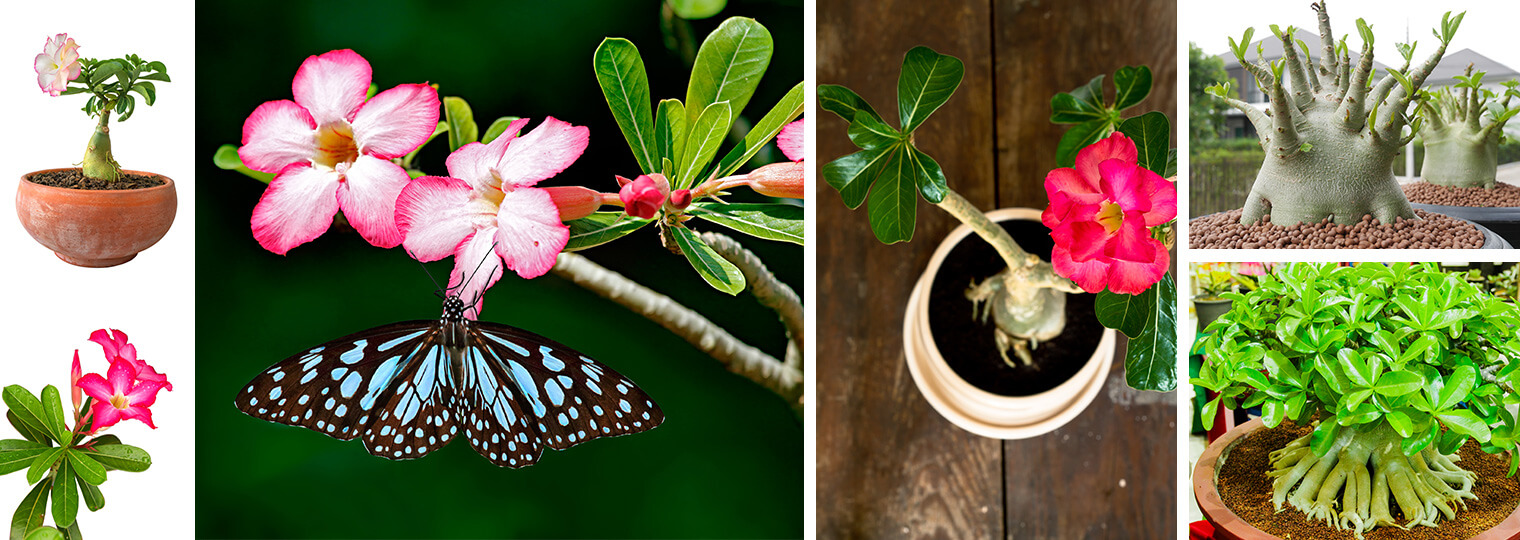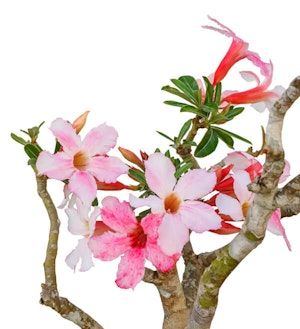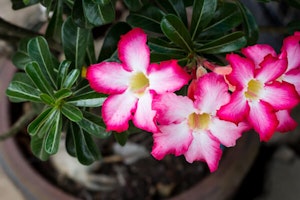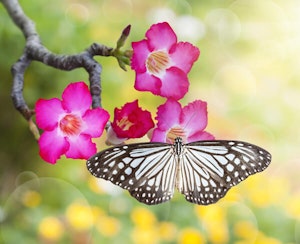 Be Inspired Blog - Arizona
Be Inspired Blog - Arizona

Key Winter Care for Adeniums
Cold-hardy adeniums, our desert rose: The Swazicum adenium (native to Southeastern Africa) is the most cold tolerant of the adenium subspecies. Perpetual pink and Crimson Star are the most popular hybrids of the Swazicum adeniums. These species have a skinnier leaf that is grayish blue in color. The Swazicum adenium of Southeastern Africa gets colder winters than that of where the more common adenium obesum naturally lives. However, the cold varieties will still need to be watched closely through the winter months. They cannot handle wet soils with cold temperatures. As the weather turns colder, stop the watering.
Winter care
The adenium obesum can handle very little winter cold. In the winter, cooler nights trigger leaf dropping and the adenium goes dormant. At this time stop all watering to allow the plant to go dormant. We highly recommend letting the adenium go dormant. This will allow for better spring growth and flowering.
-
Overwintering your adenium outside:
 In warmer, Southwestern areas, a covered porch near the house will work for overwintering your adenium outdoors. To overwinter them outdoors, you can start this outdoors as the night times temperatures hit 50 degrees or bring in for the extremely cold night. The adenium should be placed in an area that is absolutely frost free and dry (from both rain and watering). We recommend placing the plant against a wall, under a solid roof cover (perhaps under a porch roof) on the south side of your home. If outside temperatures are expected to drop into the 20’s, even plants under roofs should be moved indoors or covered. To cover the plant adequately, we recommend a covering that consists of at least two layers. The outer layer should be plastic. Both layers should be simply draped or suspended over the plant.
In warmer, Southwestern areas, a covered porch near the house will work for overwintering your adenium outdoors. To overwinter them outdoors, you can start this outdoors as the night times temperatures hit 50 degrees or bring in for the extremely cold night. The adenium should be placed in an area that is absolutely frost free and dry (from both rain and watering). We recommend placing the plant against a wall, under a solid roof cover (perhaps under a porch roof) on the south side of your home. If outside temperatures are expected to drop into the 20’s, even plants under roofs should be moved indoors or covered. To cover the plant adequately, we recommend a covering that consists of at least two layers. The outer layer should be plastic. Both layers should be simply draped or suspended over the plant.
-
Indoor winter care for your adenium:
Bringing the adenium indoors protects your plant from the possibility of freezing temperatures, which can damage and eventually kill the adenium. Once inside, we recommend that placing your adenium in a south- or west-facing window. In the house the temperatures will stay above 55 degrees F, so you will need to force dormancy by withholding all water until the leaves drop.
-
Post-frost care:
If any stems get damaged by frost or are frozen, those branches can be pruned back in the spring, either just before or after growth resumes. If they are not pruned back, the damaged branches could rot and eventually spread that rot to kill the adenium.
Spring/post-winter care
In order to resume growth in the spring, adeniums must be returned to proper light conditions. If the adenium grows indoors, the leaves will sunburn and likely fall off once the plant is moved outdoors in the spring. However, the plant will likely re-leaf with leaves that function better in the sun. In addition, the stems can also get sunburnt if the plant is placed in full sunlight too quickly or before it has leaves. To avoid this, we recommend that you ease the plant into more sun. One way you can do this is by creating temporary shade for the stems for several days. You can lightly lean cut branches with leaves from other plants against the adenium to create some shade. In the summer we recommend morning sun and afternoon shade or filtered sun all day.
 Replanting your adenium
Replanting your adenium
-
Soil:
A well-draining soil is recommended, such as a cactus soil with pumice and perlite. This type of soil allows for fast drainage and provides an airy, light soil that is great for all types of adeniums.
-
Replanting:
When you replant your adenium, raise the woody base of the plant (the caudex) between
1-4 inches (typically 1-2). This will expose the uniqueness of your adenium’s caudex. Branching roots can be saddled (draped) over a small stone for added support and attractiveness. The addition of support stones can also look especially attractive in bonsai-style pottery.
-
Pot size:
A shallow, small Bonsai pot is attractive but will greatly slow the growth rate of your adenium by restricting the root space and will dry out quicker to prevent over watering especially during the winter season. Large, deep pots allow the adenium to grow at tremendous rates during the growing season, but they will hold more moisture and take longer to dry out. This can be very dangerous going into the winter season.
Watering your adenium
-
Watering during the growing season:
During the growing season, adeniums can be watered as often as several times a week or even daily, depending on the soil mix that is used, lighting and the outside temperature. Larger pots can be watered less frequently, such as every two weeks or so during the peak growing season. For overall plant health and growth, we recommend regular watering and allowing the soil to almost dry out in between watering. You can check to see if the plant is ready to be watered by sticking your finger 1-2 inches deep into the soil. If it is almost dry, then it is time to water the plant. If it is not, wait.
-
Watering during the winter:
The need to water during dormancy depends on the soil, indoor environmental conditions, and the size of the pot. Dormant plants in smaller pots can be watered once a month, while dormant plants in larger pots may not need to be watered at all indoors in the winter. If adeniums are overwintered with temperatures
of 50 degrees F or less (whether indoors or outside under a protected area), then they should be kept bone dry regardless of the size of the pot. In this case, do not resume watering until the temperatures warm and the plant begins to show signs of growth (or flowering). This will likely occur in early April (unless the plant is in a greenhouse—then it may be earlier). When watering, we recommend that you thoroughly drench the soil (and ensure the pot can drain to prevent salt buildup).
Additional considerations
 Fertilizer:
Fertilizer:
Adeniums will benefit from a 20-20-20 fertilizer with trace nutrients, starting in April. After that, switch to a high-level phosphate when flowering begins. Hawaiian bud and bloom 5-50-17 is a great product.
Air & Wind:
Most adeniums grow best with good air circulation—but not continual wind. The more air around the plant, the more watering will be required (since this will dry the soil faster).Questions?
If you still have questions regarding the care of your adenium, stop by your local SummerWinds Nursery and speak with one of our Trusted Garden Advisors.
Sources: That Cactus Guy DFW and Desert Gardening Guides from Desert Botanical Garden

